Measuring the Soundscape Quality in Urban Spaces: A Case Study of Historic Urban Area
Abstract
1. Introduction
2. Literature Review
2.1. Sonic Environment and Urban Soundscape
2.2. Social Interaction and People Attendance in POS
2.3. People Attendance Based on the Sonic Environment
3. Methodology
3.1. Method
3.2. Case Study
4. Results
4.1. Social and Economic Features of Respondents
4.2. Quality of the Sonic Environment: Indicators Analysis
4.3. The Appeasing Sounds of the Environment
4.4. Reasons for Coming to the Studied Space
4.5. Explain Inter-Indicator Relationships
5. Discussion
6. Conclusions
Author Contributions
Funding
Institutional Review Board Statement
Informed Consent Statement
Data Availability Statement
Acknowledgments
Conflicts of Interest
Appendix A
| Coefficients a | ||||||
|---|---|---|---|---|---|---|
| Model | Unstandardized Coefficients | Standardized Coefficients | t | Sig. | ||
| B | Std. Error | Beta | ||||
| 1 | (Constant) | 3.276 | 0.556 | 5.886 | 0.000 | |
| unpleasantness and undesired noises | −0.042 | 0.095 | − 0.044 | −0.447 | 0.656 | |
| unpleasant sonic psychological effects | −0.086 | 0.109 | −0.080 | −0.787 | 0.433 | |
| deprivation of comfort through the biophony | 0.106 | 0.085 | 0.122 | 1.243 | 0.217 | |
| hearing the voice of sellers and purchasers continuously | −0.222 | 0.097 | −0.233 | −2.295 | 0.024 | |
| a. Dependent Variable: lack of people attendance. | ||||||
| Coefficients a | ||||||
|---|---|---|---|---|---|---|
| Model | Unstandardized Coefficients | Standardized Coefficients | t | Sig. | ||
| B | Std. Error | Beta | ||||
| 1 | (Constant) | 3.467 | 0.842 | 4.119 | 0.000 | |
| The variety of sounds caused by different activities in space | 0.102 | 0.089 | 0.107 | 1.139 | 0.258 | |
| The coverage and variety of plants along the street | 0.081 | 0.103 | 0.075 | 0.787 | 0.433 | |
| Geophony | −0.097 | 0.092 | −0.101 | −01.060 | 0.292 | |
| Attracting people’s attention by different voices | −0.013 | 0.086 | −0.015 | −0.154 | 0.878 | |
| Pleasantness by playing music (calm) | −0.076 | 0.097 | −0.076 | −0.790 | 0.432 | |
| Unpleasantness and undesired noises | −0.094 | 0.087 | −0.099 | −01.088 | 0.280 | |
| Unpleasant sonic psychological effects | −0.230 | 0.101 | −0.215 | −02.283 | 0.025 | |
| Deprivation of comfort through the biophony | −0.054 | 0.081 | −0.062 | −0.670 | 0.505 | |
| Attracting attention through various sounds | −0.097 | 0.094 | −0.102 | −01.031 | 0.305 | |
| The memory of past memories across certain sounds | −0.037 | 0.105 | −0.035 | −0.350 | 0.727 | |
| Hearing the sound of music | 0.307 | 0.088 | 0.319 | 3.476 | 0.001 | |
| Hearing the voices of children playing | −0.094 | 0.085 | −0.102 | −1.104 | 0.273 | |
| Hearing the voice of sellers and purchasers continuously | −0.088 | 0.093 | −0.093 | −0.945 | 0.347 | |
| Confusion in finding direction or location by hearing noises | 0.139 | 0.078 | 0.167 | 1.771 | 0.080 | |
| a. Dependent Variable: Not bringing friends and family. | ||||||
References
- Buxton, R.T.; Pearson, A.L.; Allou, C.; Fristrup, K.; Wittemyer, G. A synthesis of health benefits of natural sounds and their distribution in national parks. Proc. Natl. Acad. Sci. USA 2021, 118, e2013097118. [Google Scholar] [CrossRef] [PubMed]
- Mahdi, A.; Hosseini, A.; Pourahmad, A.; Hataminejad, H. Analysis of effective environmental factors an urban health, a case study of Qom, Iran. Habitat Int. 2016, 55, 89–99. [Google Scholar] [CrossRef]
- McMichael, A.J. The urban environment and health in a world of increasing globalization: Issues for developing countries. Bull. World Health Organ. 2000, 78, 1117–1126. [Google Scholar] [PubMed]
- Tanner, M.; Harpham, T. Urban Health in Developing Countries: Progress and Prospects; Routledge: Oxford, UK, 2014. [Google Scholar]
- Nieuwenhuijsen, M.J. New urban models for more sustainable, liveable and healthier cities post COVID-19; reducing air pollution, noise and heat island effects and increasing green space and physical activity. Environ. Int. 2021, 157, 106850. [Google Scholar] [CrossRef]
- United Nations. World Urbanization Prospects: The 2018 Revision; Department of Economic and Social Affairs: New York, NY, USA, 2019. [Google Scholar]
- King, E.; Bourdeau, E.; Zheng, X.; Pilla, F. A combined assessment of air and noise pollution on the High Line, New York City. Transp. Res. Part D Transp. Environ. 2016, 42, 91–103. [Google Scholar] [CrossRef]
- Lee, H.P.; Kumar, S. Perspectives on the Sonic Environment and Noise Mitigations during the COVID-19 Pandemic Era. Acoustics 2021, 3, 493–506. [Google Scholar] [CrossRef]
- Steele, D.; Bild, E.; Guastavino, C. Moving past the sound-noise dichotomy: How professionals of the built environment approach the sonic dimension. Cities 2023, 132, 103974. [Google Scholar] [CrossRef]
- Yuan, M.; Yin, C.; Sun, Y.; Chen, W. Examining the associations between urban built environment and noise pollution in high-density high-rise urban areas: A case study in Wuhan, China. Sustain. Cities Soc. 2019, 50, 101678. [Google Scholar] [CrossRef]
- Rehan, R.M. The phonic identity of the city urban soundscape for sustainable spaces. HBRC J. 2016, 12, 337–349. [Google Scholar] [CrossRef]
- Pijanowski, B.C.; Farina, A.; Gage, S.H.; Dumyahn, S.L.; Krause, B.L. What is soundscape ecology? An introduction and overview of an emerging new science. Landsc. Ecol. 2011, 26, 1213–1232. [Google Scholar] [CrossRef]
- WHO. Environmental Noise Guidelines for the European Region; WHO Regional Office for Europe: Copenhagen, Denmark, 2019. [Google Scholar]
- Eriksson, C.; Pershagen, G.; Nilsson, M. Biological Mechanisms Related to Cardiovascular and Metabolic Effects by Environmental Noise; WHO Regional Office for Europe: Copenhagen, Denmark, 2018. [Google Scholar]
- Basner, M.; McGuire, S. WHO environmental noise guidelines for the European region: A systematic review on environmental noise and effects on sleep. Int. J. Environ. Res. Public Health 2018, 15, 519. [Google Scholar] [CrossRef]
- Brown, A.L.; Van Kamp, I. WHO environmental noise guidelines for the European region: A systematic review of transport noise interventions and their impacts on health. Int. J. Environ. Res. Public Health 2017, 14, 873. [Google Scholar] [CrossRef]
- Hong, J.Y.; Jeon, J.Y. Exploring spatial relationships among soundscape variables in urban areas: A spatial statistical modelling approach. Landsc. Urban Plan. 2017, 157, 352–364. [Google Scholar] [CrossRef]
- Jiang, L.; Nellthorp, J. Valuing transport noise impacts in public urban spaces in the UK: Gaps, opportunities and challenges. In Proceedings of the INTER-NOISE and NOISE-CON Congress and Conference Proceedings, Madrid, Spain, 16–19 June 2019; Institute of Noise Control Engineering: Washington, DC, DC, USA, 2019; Volume 259, pp. 5204–5216. [Google Scholar]
- Huang, B.; Pan, Z.; Wang, G. A methodology to control urban traffic noise under the constraint of environmental capacity: A case study of a double-decision optimization model. Transp. Res. Part D Transp. Environ. 2015, 41, 257–270. [Google Scholar] [CrossRef]
- Yang, L.; Zhang, L.; Stettler, M.E.; Sukitpaneenit, M.; Xiao, D.; Van Dam, K.H. Supporting an integrated transportation infrastructure and public space design: A coupled simulation method for evaluating traffic pollution and microclimate. Sustain. Cities Soc. 2020, 52, 101796. [Google Scholar] [CrossRef]
- Berglund, B.; Lindvall, T.; Schwela, D.H. Guidelines for Community Noise; WHO: Geneva, Switzerland, 1999. [Google Scholar]
- ISO 12913-1:2014; Acoustics—Soundscape—Part 1: Definition and Conceptual Framework. International Organization for Standardization: Geneva, Switzerland, 2014.
- ISO/PRF TS 12913-2; Acoustics—Soundscape—Part 2: Data Collection and Reporting Requirements; ISO Technical Specification. International Organization for Standardization: Geneva, Switzerland, 2018.
- Zannin, P.H.T.; Calixto, A.; Diniz, F.B.; Ferreira, J.A.C. A survey of urban noise annoyance in a large Brazilian city: The importance of a subjective analysis in conjunction with an objective analysis. Environ. Impact Assess. Rev. 2003, 23, 245–255. [Google Scholar] [CrossRef]
- Dumyahn, S.L.; Pijanowski, B.C. Soundscape conservation. Landsc. Ecol. 2011, 26, 1327–1344. [Google Scholar] [CrossRef]
- Maris, E.; Stalen, P.J.; Vermunt, R.; Steensma, H. Noise within the social context: Annoyance reduction through fair procedures. J. Acoust. Soc. Am. 2007, 121, 2000–2010. [Google Scholar] [CrossRef]
- Sun, K.; Echevarria Sanchez, G.M.; De Coensel, B.; Van Renterghem, T.; Talsma, D.; Botteldooren, D. Personal audiovisual aptitude influences the interaction between landscape and soundscape appraisal. Front. Psychol. 2018, 9, 780. [Google Scholar] [CrossRef]
- Dubois, D.; Guastavino, C.; Raimbault, M. A cognitive approach to urban soundscapes: Using verbal data to access everyday life auditory categories. Acta Acust. United Acust. 2006, 92, 865–874. [Google Scholar]
- Schafer, R.M. The Soundscape: Our Sonic Environment and the Tuning of the World; Destiny Books: Rochester, NY, USA, 1994. [Google Scholar]
- Bowles, A.; Schulte-Fortkamp, B. Noise as an indicator of quality of life: Advances in measurement of noise and noise effects on humans and animals in the environment. Acoust. Today 2008, 4, 35. [Google Scholar] [CrossRef]
- Pheasant, R.J.; Fisher, M.N.; Watts, G.R.; Whitaker, D.J.; Horoshenkov, K.V. The importance of auditory-visual interaction in the construction of ‘tranquil space’. J. Environ. Psychol. 2010, 30, 501–509. [Google Scholar] [CrossRef]
- European Environment Agency. Noise in Europe 2014; EEA Report No 10/2014; Publications Office of the European Union: Luxembourg, 2014. [Google Scholar]
- Fiedler, P.E.K.; Zannin, P.H.T. Evaluation of noise pollution in urban traffic hubs—Noise maps and measurements. Environ. Impact Assess. Rev. 2015, 51, 1–9. [Google Scholar] [CrossRef]
- Aletta, F.; Oberman, T.; Kang, J. Associations between positive health-related effects and soundscapes perceptual constructs: A systematic review. Int. J. Environ. Res. Public Health 2018, 15, 2392. [Google Scholar] [CrossRef] [PubMed]
- Berkouk, D.; Bouzir, T.A.K.; Maffei, L.; Masullo, M. Examining the Associations between Oases Soundscape Components and Walking Speed: Correlation or Causation? Sustainability 2020, 12, 4619. [Google Scholar] [CrossRef]
- Dein, J.; Rüdisser, J. Landscape influence on biophony in an urban environment in the European Alps. Landsc. Ecol. 2020, 35, 1875–1889. [Google Scholar] [CrossRef]
- Hao, Z.; Zhan, H.; Zhang, C.; Pei, N.; Sun, B.; He, J.; Wu, R.; Xu, X.; Wang, C. Assessing the effect of human activities on biophony in urban forests using an automated acoustic scene classification model. Ecol. Indic. 2022, 144, 109437. [Google Scholar] [CrossRef]
- Farina, A. Soundscape Ecology: Principles, Patterns, Methods and Applications; Springer Science Business Media: Berlin/Heidelberg, Germany, 2013. [Google Scholar]
- Mullet, T.C.; Gage, S.H.; Morton, J.M.; Huettmann, F. Temporal and spatial variation of a winter soundscape in south-central Alaska. Landsc. Ecol. 2016, 31, 1117–1137. [Google Scholar] [CrossRef]
- Brown, A.L.; Kang, J.; Gjestland, T. Towards standardization in soundscape preference assessment. Appl. Acoust. 2011, 72, 387–392. [Google Scholar] [CrossRef]
- Dickinson, P.J. Outdoor Recreational Noise, a Review of Noise in National Parks and Motor Sport Activities; International Institute of Noise Control Engineering: Washington, DC, DC, USA, 2012. [Google Scholar]
- Aletta, F.; Kang, J.; Fuda, S.; Astolfi, A. The effect of walking sounds from different walked-on materials on the soundscape of urban parks. J. Environ. Eng. Landsc. Manag. 2016, 24, 165–175. [Google Scholar] [CrossRef]
- Engel, M.S.; Paas, B.; Schneider, C.; Pfaffenbach, C.; Fels, J. Perceptual studies on air quality and sound through urban walks. Cities 2018, 83, 173–185. [Google Scholar] [CrossRef]
- Sudarsono, A.S.; Lam, Y.W.; Davies, W.J. The effect of sound level on perception of reproduced soundscapes. Appl. Acoust. 2016, 110, 53–60. [Google Scholar] [CrossRef]
- Yamagata, Y.; Murakami, D.; Yoshida, T. Evaluating walkability using mobile GPS data. In Spatial Analysis Using Big Data; Academic Press: Cambridge, MA, USA, 2020; pp. 239–257. [Google Scholar]
- Bild, E.; Pfeffer, K.; Coler, M.; Rubin, O.; Bertolini, L. Public space users’ soundscape evaluations in relation to their activities. An Amsterdam-based study. Front. Psychol. 2018, 9, 1593. [Google Scholar] [CrossRef]
- Madanipour, A. Urban Design, Space and Society; Springer: Berlin/Heidelberg, Germany, 2014. [Google Scholar]
- Moura, F.; Cambra, P.; Gonçalves, A.B. Measuring walkability for distinct pedestrian groups with a participatory assessment method: A case study in Lisbon. Landsc. Urban Plan. 2017, 157, 282–296. [Google Scholar] [CrossRef]
- Villanueva, K.; Knuiman, M.; Nathan, A.; Giles-Corti, B.; Christian, H.; Foster, S.; Bull, F. The impact of neighborhood walkability on walking: Does it differ across adult life stage and does neighborhood buffer size matter? Health Place 2014, 25, 43–46. [Google Scholar] [CrossRef]
- Kim, Y.H.; Hwang, I.H.; Hong, J.Y.; Lee, S.C. Effects of vegetation on soundscape of an urban religious precinct: Case study of Myeong-dong cathedral in Seoul. Build. Environ. 2019, 155, 389–398. [Google Scholar] [CrossRef]
- Van Renterghem, T. Towards explaining the positive effect of vegetation on the perception of environmental noise. Urban For. Urban Green. 2019, 40, 133–144. [Google Scholar] [CrossRef]
- Botteldooren, D.; Andringa, T.; Aspuru, I.; Brown, A.L.; Dubois, D.; Guastavino, C.; Kang, J.; Lavandier, C.; Nilsson, M.; Preis, A.; et al. From sonic environment to soundscape. Soundsc. Built Environ. 2015, 36, 17–42. [Google Scholar]
- Bouzir, T.A.K.; Zemmouri, N.; Berkouk, D. Assessment and analysis of noise pollution in Biskra public gardens (Algeria). AIP Conf. Proc. 2018, 1968, 030069. [Google Scholar]
- Weinzimmer, D.; Newman, P.; Taff, D.; Benfield, J.; Lynch, E.; Bell, P. Human responses to simulated motorized noise in national parks. Leis. Sci. 2014, 36, 251–267. [Google Scholar] [CrossRef]
- Liu, J.; Kang, J.; Behm, H.; Luo, T. Effects of landscape on soundscape perception: Soundwalks in city parks. Landsc. Urban Plan. 2014, 123, 30–40. [Google Scholar] [CrossRef]
- Sanchez, G.M.E.; Van Renterghem, T.; Sun, K.; De Coensel, B.; Botteldooren, D. Using virtual reality for assessing the role of noise in the audio-visual design of an urban public space. Landsc. Urban Plan. 2017, 167, 98–107. [Google Scholar] [CrossRef]
- Jiang, S. Therapeutic landscapes and healing gardens: A review of Chinese literature in relation to the studies in western countries. Front. Archit. Res. 2014, 3, 141–153. [Google Scholar] [CrossRef]
- Axelsson, O.; Guastavino, C.; Payne, S.R. (Eds.) Soundscape Assessment; Frontiers Media SA: Lausanne, Switzerland, 2020. [Google Scholar]
- Gozalo, G.R.; Morillas, J.M.B.; González, D.M.; Moraga, P.A. Relationships among satisfaction, noise perception, and use of urban green spaces. Sci. Total Environ. 2018, 624, 438–450. [Google Scholar] [CrossRef] [PubMed]
- Koprowska, K.; Łaszkiewicz, E.; Kronenberg, J.; Marcińczak, S. Subjective perception of noise exposure in relation to urban green space availability. Urban For. Urban Green. 2018, 31, 93–102. [Google Scholar] [CrossRef]
- Sarkar, C.; Webster, C.; Pryor, M.; Tang, D.; Melbourne, S.; Zhang, X.; Jianzheng, L. Exploring associations between urban green, street design and walking: Results from the Greater London boroughs. Landsc. Urban Plan. 2015, 143, 112–125. [Google Scholar] [CrossRef]
- Calleri, C.; Astolfi, A.; Pellegrino, A.; Aletta, F.; Shtrepi, L.; Bo, E.; Di Stefano, M.; Orecchia, P. The effect of Soundscapes and Lightscapes on the Perception of Safety and Social Presence Analyzed in a Laboratory Experiment. Sustainability 2019, 11, 3000. [Google Scholar] [CrossRef]
- Cochran, W.G. Sampling Techniques; John Wiley and Sons, Inc.: New York, NY, USA, 2007. [Google Scholar]
- Tehran Municipality. Tehran Noise Pollution Report; Tehran Air Quality Control Company: Tehran, Iran, 2019.
- Carson, R. Silent Spring; Houghton Mifflin Company: Boston, MA, USA, 2009. [Google Scholar]
- Barber, J.R.; Burdett, C.L.; Reed, S.E.; Warner, K.A.; Formichella, C.; Crooks, K.R.; Theobald, D.M.; Fristrup, K.M. Anthropogenic noise exposure in protected natural areas: Estimating the scale of ecological consequences. Landsc. Ecol. 2011, 26, 1281–1295. [Google Scholar] [CrossRef]
- Beatley, T. Celebrating the Natural Soundscapes of Cities; The Nature of Cities: New York, NY, USA, 2013. [Google Scholar]
- Jacobs, J. The Death and Life of Great American Cities; The Yale Law Journal Company: New Haven, CT, USA, 1961. [Google Scholar]
- Truss, C.; Gill, J. Managing the HR function: The role of social capital. Pers. Rev. 2009, 38, 674–695. [Google Scholar] [CrossRef]
- Hall, P.M.; Spencer-Hall, D.A. The social conditions of the negotiated order. Urban Life 1982, 11, 328–349. [Google Scholar] [CrossRef]
- Gehl, J. Public spaces for a changing public life. In Open Space: People Space; Taylor & Francis: Oxford, UK, 2007; pp. 23–30. [Google Scholar]
- Aram, F.; Gharaei, F.; Habibi, M. A Survey on the Role of Periodical Markets in the Sociability of Neighborhood’s Residents and Social Interactions, Case Study: Hamedan. Arman. Archit. Urban Dev. 2018, 11, 135–145. [Google Scholar]
- Kowkabi, L. Revitalization of bio infrastructure network, an approach to urban regeneration: A case study of the qanats of Tehran. Urban For. Urban Green. 2021, 59, 127020. [Google Scholar] [CrossRef]
- Huang, Y.F. An inventory model under two levels of trade credit and limited storage space derived without derivatives. Appl. Math. Model. 2006, 30, 418–436. [Google Scholar] [CrossRef]
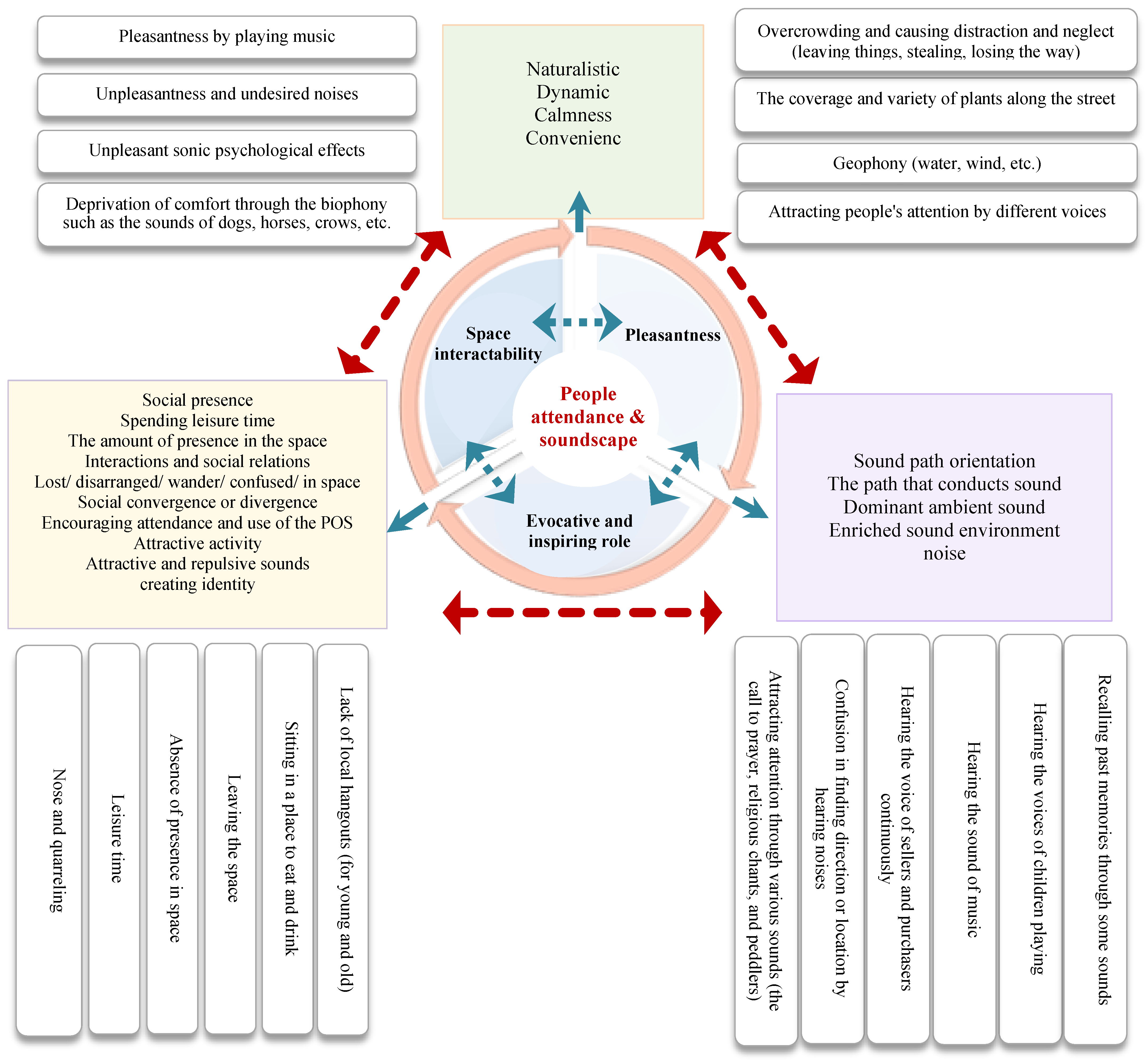
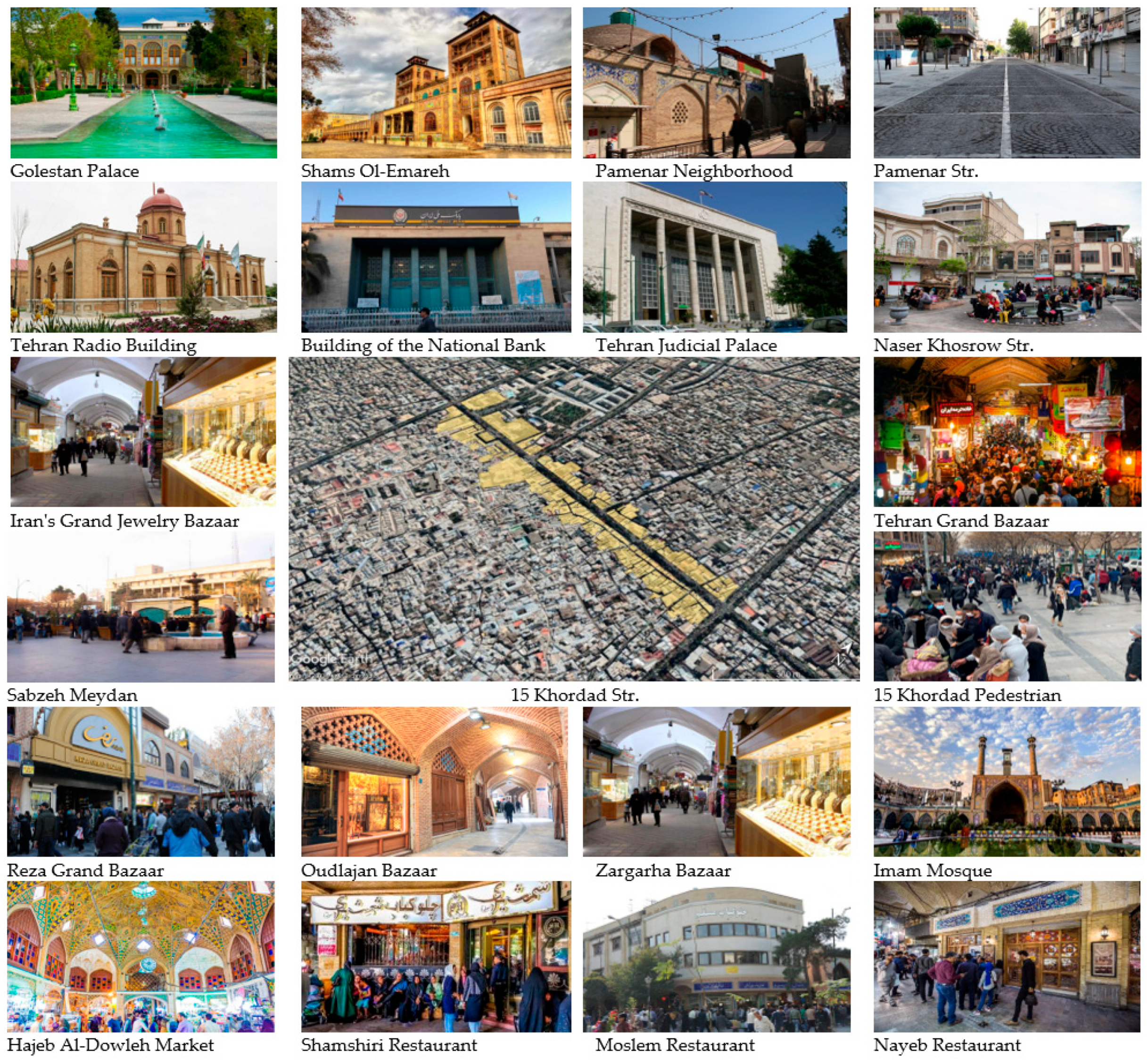
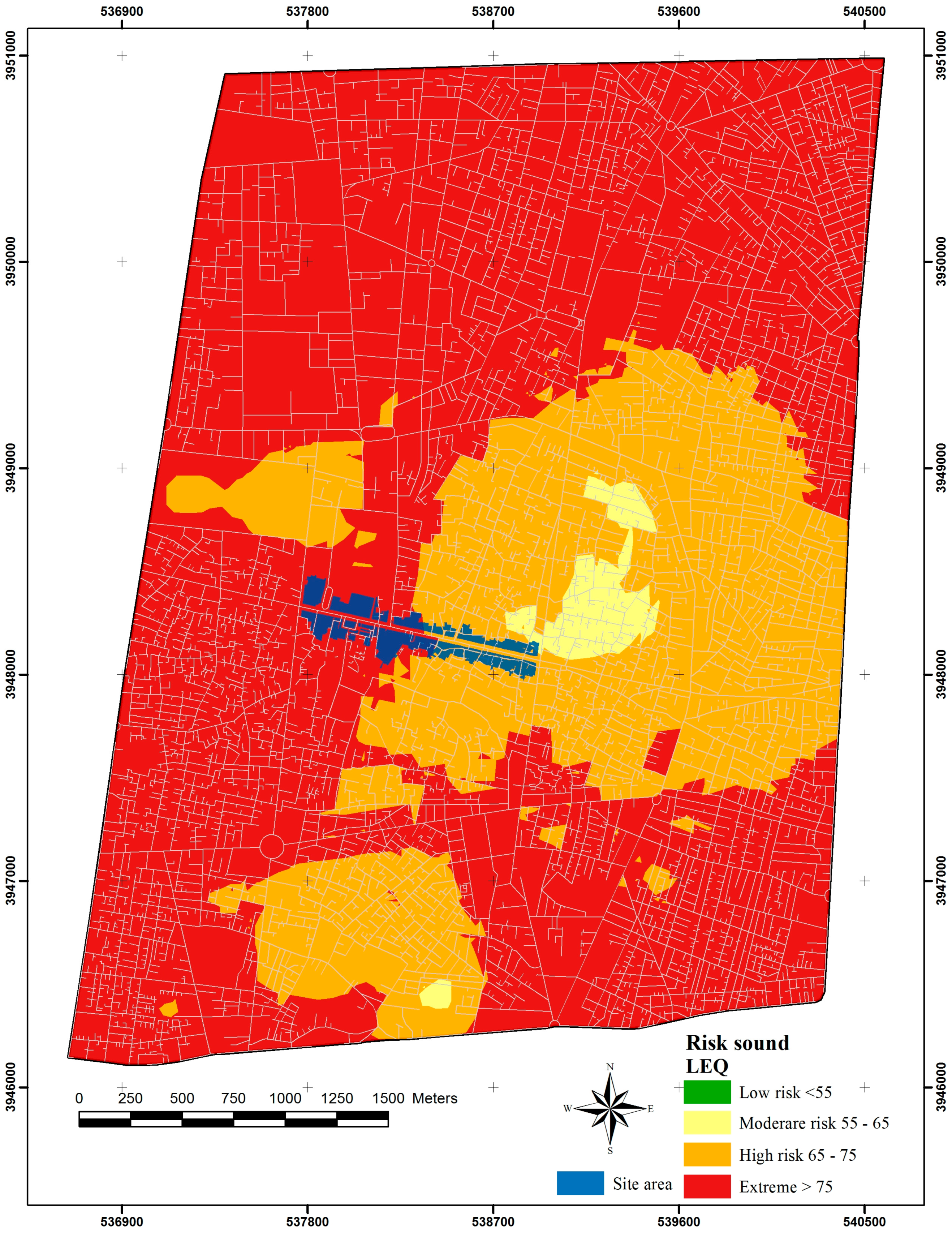
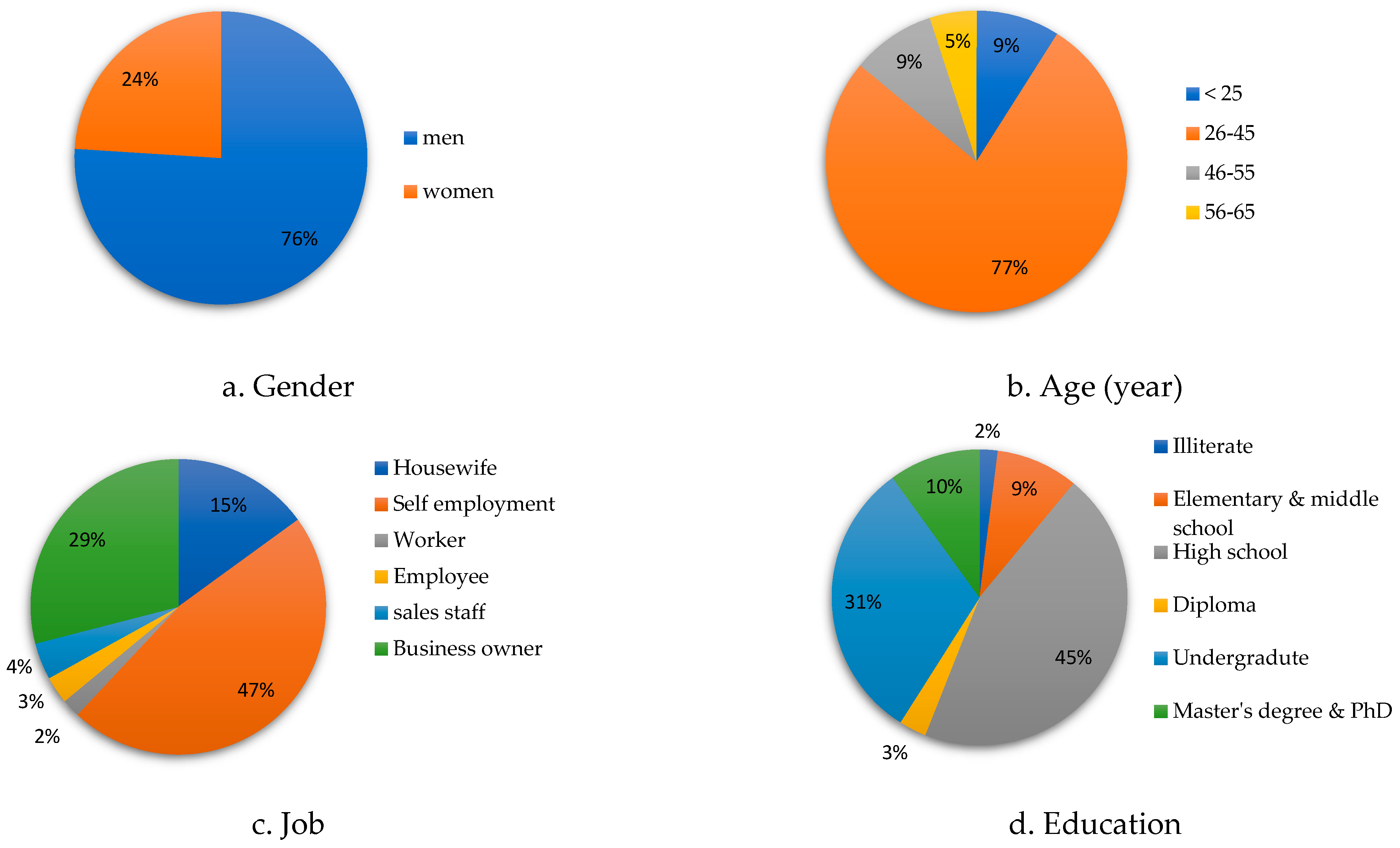
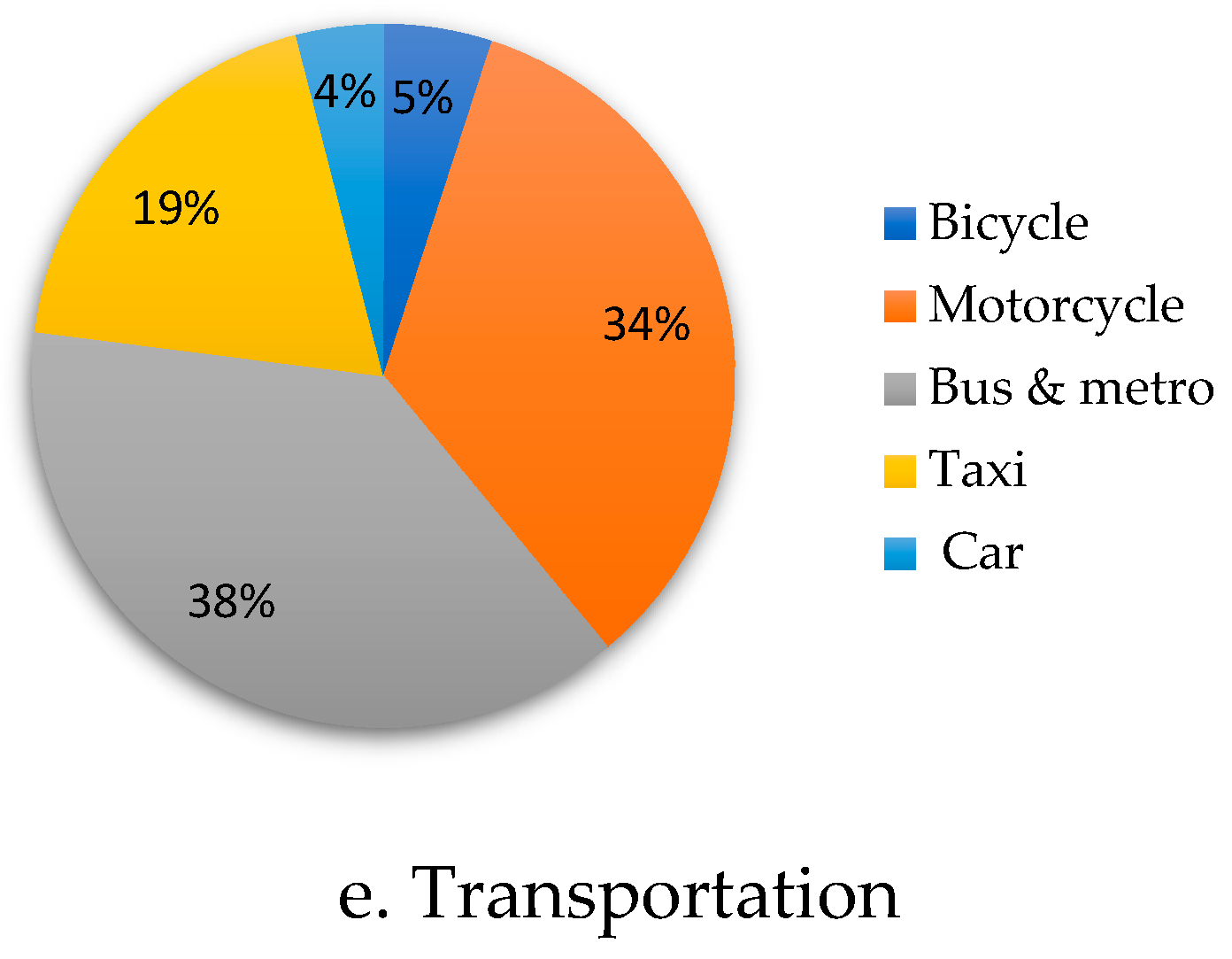
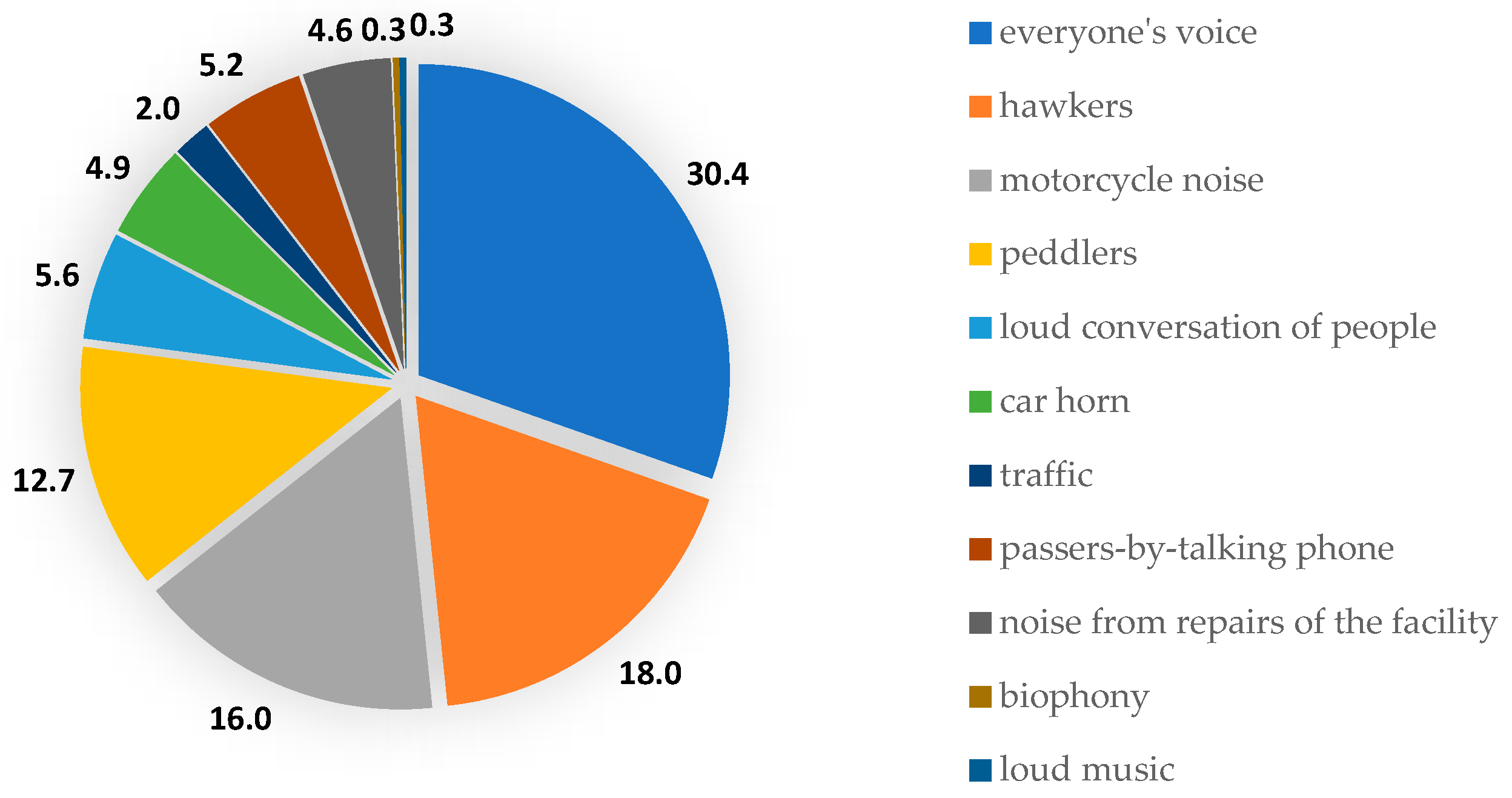
| Variable | Very Low | Low | Moderate | High | Very High | Mean | SD | Variance |
|---|---|---|---|---|---|---|---|---|
| Unpleasantness and undesired noises | 3.9 | 10.8 | 28.4 | 46.1 | 10.8 | 3.4 | 0.962 | 0.926 |
| Unpleasant sonic psychological effects | 2 | 6.9 | 30.4 | 49 | 11.8 | 3.6 | 0.856 | 0.734 |
| The coverage and variety of plants along the street | 6.9 | 28.4 | 52 | 9.8 | 2.9 | 2.7 | 0.843 | 0.711 |
| Geophony (water, wind, etc.) | 14.7 | 44.1 | 31.4 | 5.9 | 3.9 | 2.4 | 0.946 | 0.896 |
| Attracting people’s attention by different voices | 3.9 | 13.7 | 38.2 | 31.4 | 12.7 | 3.3 | 1.001 | 1.003 |
| Pleasantness by playing music (calm) | 5.9 | 21.6 | 49 | 18.6 | 4.9 | 2.9 | 0.916 | 0.839 |
| Deprivation of comfort through the biophony such as the sounds of dogs, horses, crows, etc. | 20.6 | 43.1 | 24.5 | 5.9 | 5.9 | 2.3 | 1.056 | 1.116 |
| Lack of familiarity with the space | 4.9 | 31.4 | 37.3 | 23.5 | 2.9 | 2.9 | 0.925 | 0.938 |
| Reducing the prosperity of some activities (such as business) | 14.7 | 45.1 | 28.4 | 7.8 | 3.9 | 2.4 | 0.968 | 0.938 |
| The attractiveness of the space despite the loudness of the noise | 6.9 | 43.1 | 36.3 | 8.8 | 4.9 | 2.7 | 0.923 | 0.852 |
| Variable | Very Low | Low | Moderate | High | Very High | Mean | SD | Variance |
|---|---|---|---|---|---|---|---|---|
| Attracting attention through various sounds (the call to prayer, religious chants, and peddlers) | 5.9 | 20.6 | 41.2 | 27.5 | 4.9 | 3.1 | 0.958 | 0.918 |
| Recalling past memories through some sounds | 4.9 | 17.6 | 50 | 23.5 | 3.9 | 3 | 0.8779 | 0.771 |
| Hearing the sound of music | 16.7 | 44.1 | 30.4 | 4.9 | 3.9 | 2.3 | 0.95 | 0.904 |
| Hearing the voices of children playing | 22.5 | 50 | 18.6 | 3.9 | 4.9 | 2.2 | 0.992 | 0.985 |
| Hearing the voice of sellers and purchasers continuously | 2.9 | 6.9 | 21.6 | 46.1 | 22.5 | 3.7 | 0.971 | 0.943 |
| The variety of sounds caused by different activities in space | 2.9 | 11.8 | 30.4 | 42.2 | 12.7 | 3.5 | 0.962 | 0.926 |
| Overcrowding and causing distraction and neglect (leaving things, stealing, losing track) | 16.7 | 42.2 | 26.5 | 8.8 | 5.9 | 2.4 | 1.058 | 1.121 |
| Confusion in finding direction or location by hearing noises | 14.7 | 26.5 | 30.4 | 24.5 | 3.9 | 2.7 | 1.1 | 1.211 |
| Reducing the identity of the space | 13.7 | 49 | 28.4 | 5.9 | 2.9 | 2.3 | 0.897 | 0.805 |
| Variable | Very Low | Low | Moderate | High | Very High | Mean | SD | Variance |
|---|---|---|---|---|---|---|---|---|
| Lack of people attendance | 18.6 | 51 | 23.5 | 2.9 | 3.9 | 2.2 | 0.921 | 0.85 |
| Leisure time | 4.9 | 18.6 | 41.2 | 21.6 | 13.7 | 3.2 | 1.056 | 1.116 |
| Lack of local hangouts (for young and old) | 26.5 | 47.1 | 18.6 | 5.9 | 2 | 2.1 | 0.928 | 0.862 |
| Leaving the space | 14.7 | 40.2 | 32.4 | 8.8 | 3.9 | 2.5 | 0.982 | 0.964 |
| Sitting in a place to eat and drink | 4.9 | 18.6 | 49 | 24.5 | 2.9 | 3 | 0.867 | 0.752 |
| Noise and quarreling | 15.7 | 44.1 | 32.4 | 4.9 | 2.9 | 2.3 | 0.908 | 0.825 |
| No returning to the space | 28.4 | 47.1 | 13.7 | 5.9 | 4.9 | 2.1 | 1.046 | 1.095 |
| Not bringing friends and family | 15.7 | 39.2 | 35.3 | 7.8 | 2 | 2.4 | 0.915 | 0.839 |
| Lack of presence of different age groups (children and elderly) | 7.8 | 37.3 | 45.1 | 5.9 | 3.9 | 2.6 | 0.869 | 0.756 |
| Favorable sounds and increase (continuity) attendance | 22.5 | 52 | 20.6 | 2.9 | 2 | 2.1 | 0.85 | 0.723 |
| Model Summary | ANOVA a | ||||||
|---|---|---|---|---|---|---|---|
| R | R Square | Adjusted R Square | Std. Error of the Estimate | df | Mean Square | F | Sig. |
| 0.313 a | 0.098 | 0.060 | 0.8934 | 4 | 2.096 | 2.626 | 0.039 b |
| a. Predictors: (Constant), hearing the voice of sellers and purchasers continuously, deprivation of comfort through the biophony, unpleasantness and undesired noises, and unpleasant sonic psychological effects | a. Dependent variable: lack of people attendance b. Predictors: (Constant), hearing the voice of sellers and purchasers continuously, deprivation of comfort through the biophony, unpleasantness and undesired noises, and unpleasant sonic psychological effects | ||||||
| Model Summary | ANOVA a | ||||||
|---|---|---|---|---|---|---|---|
| R | R Square | Adjusted R Square | Std. Error of the Estimate | df | Mean Square | F | Sig. |
| 0.594 a | 0.353 | 0.249 | 0.79381 | 14 | 2.135 | 3.387 | 0.000 b |
| a. Predictors: (Constant), all pleasantness and evocative and inspiring role indicators | a. Dependent variable: not bringing friends and family b. All pleasantness and evocative and inspiring role indicators | ||||||
Disclaimer/Publisher’s Note: The statements, opinions and data contained in all publications are solely those of the individual author(s) and contributor(s) and not of MDPI and/or the editor(s). MDPI and/or the editor(s) disclaim responsibility for any injury to people or property resulting from any ideas, methods, instructions or products referred to in the content. |
© 2023 by the authors. Licensee MDPI, Basel, Switzerland. This article is an open access article distributed under the terms and conditions of the Creative Commons Attribution (CC BY) license (https://creativecommons.org/licenses/by/4.0/).
Share and Cite
Hosseini, A.; Kowkabi, L. Measuring the Soundscape Quality in Urban Spaces: A Case Study of Historic Urban Area. Sustainability 2023, 15, 4255. https://doi.org/10.3390/su15054255
Hosseini A, Kowkabi L. Measuring the Soundscape Quality in Urban Spaces: A Case Study of Historic Urban Area. Sustainability. 2023; 15(5):4255. https://doi.org/10.3390/su15054255
Chicago/Turabian StyleHosseini, Ali, and Leila Kowkabi. 2023. "Measuring the Soundscape Quality in Urban Spaces: A Case Study of Historic Urban Area" Sustainability 15, no. 5: 4255. https://doi.org/10.3390/su15054255
APA StyleHosseini, A., & Kowkabi, L. (2023). Measuring the Soundscape Quality in Urban Spaces: A Case Study of Historic Urban Area. Sustainability, 15(5), 4255. https://doi.org/10.3390/su15054255







